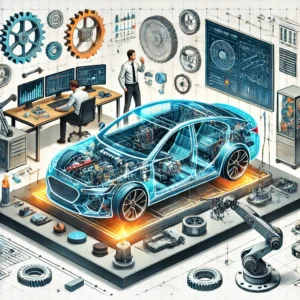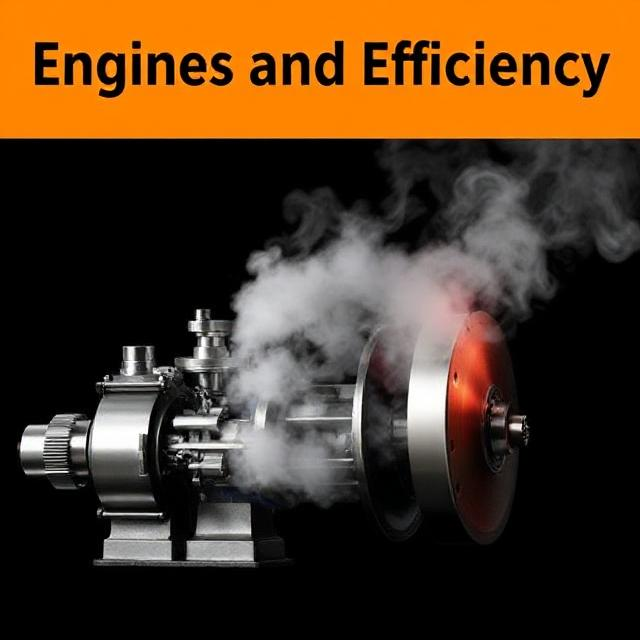Automotive engineering is the branch of engineering that focuses on the design, development, production, and testing of vehicles and their systems. It involves everything that makes a vehicle function, from the engine that powers the car to the wheels that help it move. It’s a fascinating and complex field that combines various disciplines, including mechanical engineering, electrical engineering, materials science, and computer science.

Automotive engineers work on vehicles like cars, trucks, motorcycles, buses, and even electric vehicles (EVs). Their primary goal is to create vehicles that are safe, efficient, and environmentally friendly.
Key Areas in Automotive Engineering
Automotive engineering covers many different fields. Here are some of the major areas:
- Vehicle Design and Manufacturing
This area focuses on creating the overall look and structure of the vehicle. It includes designing the body, interior, and exterior, as well as how the parts fit together. The process involves using CAD (Computer-Aided Design) software to create blueprints and models of the vehicle. - Powertrain Engineering
Powertrain engineers work on the engine, transmission, and other components that help the vehicle move. This includes designing engines (like gasoline, diesel, or electric), fuel systems, and gearboxes to ensure the vehicle performs well and efficiently. - Chassis and Suspension Engineering
The chassis is the frame of the car, and suspension systems control how the car handles bumps and road conditions. Engineers focus on designing a chassis that is lightweight, strong, and safe. They also design the suspension to give the car a smooth and stable ride, ensuring comfort and safety for passengers. - Electrical and Electronics Engineering
Modern cars are filled with complex electrical systems, from sensors and entertainment systems to safety features like airbags and electric power steering. Electrical engineers design and maintain the wiring, control systems, and electronic components inside the vehicle. - Safety Engineering
Safety is a top priority in automotive engineering. Engineers design safety features like airbags, seatbelts, crumple zones (areas of the vehicle that absorb impact in a crash), and stability control systems. They also test vehicles for crashworthiness to meet safety standards. - Environmental Engineering
With increasing concerns about climate change, automotive engineers are working hard to develop vehicles that are more eco-friendly. This includes designing electric vehicles (EVs), hybrid vehicles, and improving fuel efficiency in traditional gasoline and diesel engines. Engineers also focus on reducing vehicle emissions and making cars more energy-efficient. - Autonomous Vehicle Technology
Self-driving cars are a major area of development in automotive engineering. These vehicles use sensors, cameras, and artificial intelligence (AI) to navigate without human intervention. Engineers work on improving the algorithms and systems that make self-driving cars safe and reliable.
The Process of Automotive Engineering
Automotive engineering involves several stages, from initial concept to final production. Let’s break down these stages:
- Conceptualization and Design
The first step in building any vehicle is to create a concept. Engineers and designers brainstorm ideas, focusing on the purpose of the vehicle (family car, sports car, commercial vehicle, etc.). The design team creates initial sketches and uses 3D CAD software to build digital models of the car. - Prototype Development
Once the design is approved, engineers build a prototype — a physical model of the vehicle. This prototype helps test various systems, from the engine to the suspension, to ensure everything works as intended. Engineers conduct crash tests and other simulations to check for safety and performance. - Testing and Refinement
After the prototype is built, the vehicle undergoes rigorous testing. This includes road tests to check its handling, fuel efficiency, and comfort. Durability tests ensure the vehicle can handle extreme conditions like heat, cold, and rough roads. Engineers also test the car’s safety features in real-world conditions. - Mass Production
Once the prototype has passed all tests and is ready for release, the vehicle enters mass production. This involves setting up assembly lines where thousands of cars are built in a short period. The production process involves careful coordination of materials, assembly workers, and equipment to ensure each car is built to specifications. - Quality Control and Maintenance
After the vehicle is produced, quality control checks are performed to ensure it meets safety and performance standards. Engineers also design maintenance procedures to keep the car running smoothly throughout its life, such as regular oil changes, brake checks, and tire rotations.
Challenges in Automotive Engineering
Automotive engineers face several challenges in their work. Some of these include:
- Environmental Concerns
As the world moves towards sustainability, automotive engineers are focusing on creating cars that produce fewer emissions and use less energy. This has led to the rise of electric and hybrid vehicles, but there are still challenges related to battery technology, charging infrastructure, and raw material sourcing. - Cost and Affordability
Designing and manufacturing high-quality vehicles is expensive. Engineers must balance safety, performance, and environmental friendliness while keeping costs affordable for consumers. - Technological Advancements
The automotive industry is rapidly advancing with new technologies like autonomous driving, artificial intelligence, and electric powertrains. Automotive engineers must keep up with these advancements to stay competitive and meet the growing demand for cutting-edge features. - Global Competition
The automotive industry is highly competitive, with companies from all over the world constantly pushing the boundaries of what’s possible. Engineers must find innovative solutions to stay ahead of the competition while ensuring safety and quality.
Career Paths in Automotive Engineering
Automotive engineering offers various career paths, depending on your interests. Here are some examples:
- Design Engineer – Focuses on the aesthetic design and functionality of vehicle components.
- Powertrain Engineer – Works on engines, transmissions, and other parts of the powertrain system.
- Safety Engineer – Specializes in crash testing, safety features, and improving vehicle safety.
- Manufacturing Engineer – Manages the assembly line process, ensuring vehicles are built efficiently and to a high standard.
- Electrical Engineer – Focuses on the electrical systems inside the vehicle, including power systems and electronics.
The Future of Automotive Engineering
The future of automotive engineering is exciting. We can expect continued advancements in:
- Electric Vehicles (EVs) – As the demand for cleaner vehicles grows, EV technology will continue to improve, making electric cars more affordable and efficient.
- Autonomous Vehicles – Self-driving cars are on the horizon, and automotive engineers are working to make them a reality with more advanced sensors, AI, and safety features.
- Connectivity – Cars are becoming more connected, with features like real-time traffic updates, infotainment systems, and vehicle-to-vehicle communication.
- Sustainability – Engineers are focusing on building more sustainable vehicles using lighter materials, better fuel efficiency, and recycling technologies.
Summary:
Automotive engineering is a dynamic field that focuses on designing, developing, and testing vehicles. It involves many areas such as vehicle design, powertrain engineering, safety systems, electrical systems, and environmental considerations. Automotive engineers play a crucial role in creating vehicles that are safe, efficient, and eco-friendly. With advancements in electric vehicles, autonomous driving, and sustainable technologies, the future of automotive engineering looks exciting, offering new challenges and opportunities for innovation.











